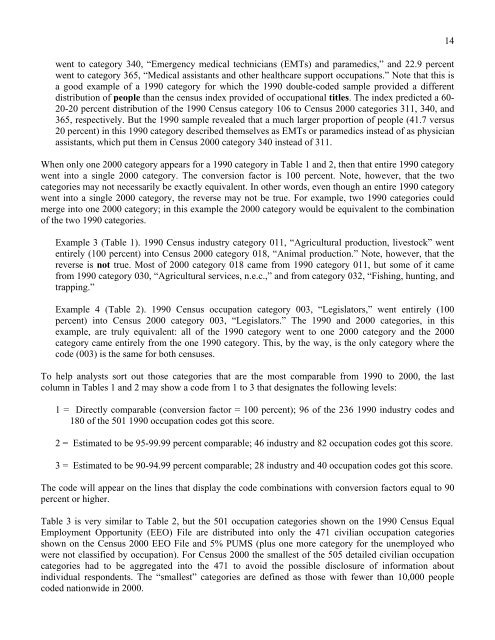The Relationship Between The 1990 Census and ... - Census Bureau
The Relationship Between The 1990 Census and ... - Census Bureau
The Relationship Between The 1990 Census and ... - Census Bureau
You also want an ePaper? Increase the reach of your titles
YUMPU automatically turns print PDFs into web optimized ePapers that Google loves.
went to category 340, “Emergency medical technicians (EMTs) <strong>and</strong> paramedics,” <strong>and</strong> 22.9 percent<br />
went to category 365, “Medical assistants <strong>and</strong> other healthcare support occupations.” Note that this is<br />
a good example of a <strong>1990</strong> category for which the <strong>1990</strong> double-coded sample provided a different<br />
distribution of people than the census index provided of occupational titles. <strong>The</strong> index predicted a 60-<br />
20-20 percent distribution of the <strong>1990</strong> <strong>Census</strong> category 106 to <strong>Census</strong> 2000 categories 311, 340, <strong>and</strong><br />
365, respectively. But the <strong>1990</strong> sample revealed that a much larger proportion of people (41.7 versus<br />
20 percent) in this <strong>1990</strong> category described themselves as EMTs or paramedics instead of as physician<br />
assistants, which put them in <strong>Census</strong> 2000 category 340 instead of 311.<br />
When only one 2000 category appears for a <strong>1990</strong> category in Table 1 <strong>and</strong> 2, then that entire <strong>1990</strong> category<br />
went into a single 2000 category. <strong>The</strong> conversion factor is 100 percent. Note, however, that the two<br />
categories may not necessarily be exactly equivalent. In other words, even though an entire <strong>1990</strong> category<br />
went into a single 2000 category, the reverse may not be true. For example, two <strong>1990</strong> categories could<br />
merge into one 2000 category; in this example the 2000 category would be equivalent to the combination<br />
of the two <strong>1990</strong> categories.<br />
Example 3 (Table 1). <strong>1990</strong> <strong>Census</strong> industry category 011, “Agricultural production, livestock” went<br />
entirely (100 percent) into <strong>Census</strong> 2000 category 018, “Animal production.” Note, however, that the<br />
reverse is not true. Most of 2000 category 018 came from <strong>1990</strong> category 011, but some of it came<br />
from <strong>1990</strong> category 030, “Agricultural services, n.e.c.,” <strong>and</strong> from category 032, “Fishing, hunting, <strong>and</strong><br />
trapping.”<br />
Example 4 (Table 2). <strong>1990</strong> <strong>Census</strong> occupation category 003, “Legislators,” went entirely (100<br />
percent) into <strong>Census</strong> 2000 category 003, “Legislators.” <strong>The</strong> <strong>1990</strong> <strong>and</strong> 2000 categories, in this<br />
example, are truly equivalent: all of the <strong>1990</strong> category went to one 2000 category <strong>and</strong> the 2000<br />
category came entirely from the one <strong>1990</strong> category. This, by the way, is the only category where the<br />
code (003) is the same for both censuses.<br />
To help analysts sort out those categories that are the most comparable from <strong>1990</strong> to 2000, the last<br />
column in Tables 1 <strong>and</strong> 2 may show a code from 1 to 3 that designates the following levels:<br />
1 = Directly comparable (conversion factor = 100 percent); 96 of the 236 <strong>1990</strong> industry codes <strong>and</strong><br />
180 of the 501 <strong>1990</strong> occupation codes got this score.<br />
2 = Estimated to be 95-99.99 percent comparable; 46 industry <strong>and</strong> 82 occupation codes got this score.<br />
3 = Estimated to be 90-94.99 percent comparable; 28 industry <strong>and</strong> 40 occupation codes got this score.<br />
<strong>The</strong> code will appear on the lines that display the code combinations with conversion factors equal to 90<br />
percent or higher.<br />
Table 3 is very similar to Table 2, but the 501 occupation categories shown on the <strong>1990</strong> <strong>Census</strong> Equal<br />
Employment Opportunity (EEO) File are distributed into only the 471 civilian occupation categories<br />
shown on the <strong>Census</strong> 2000 EEO File <strong>and</strong> 5% PUMS (plus one more category for the unemployed who<br />
were not classified by occupation). For <strong>Census</strong> 2000 the smallest of the 505 detailed civilian occupation<br />
categories had to be aggregated into the 471 to avoid the possible disclosure of information about<br />
individual respondents. <strong>The</strong> “smallest” categories are defined as those with fewer than 10,000 people<br />
coded nationwide in 2000.<br />
14
















